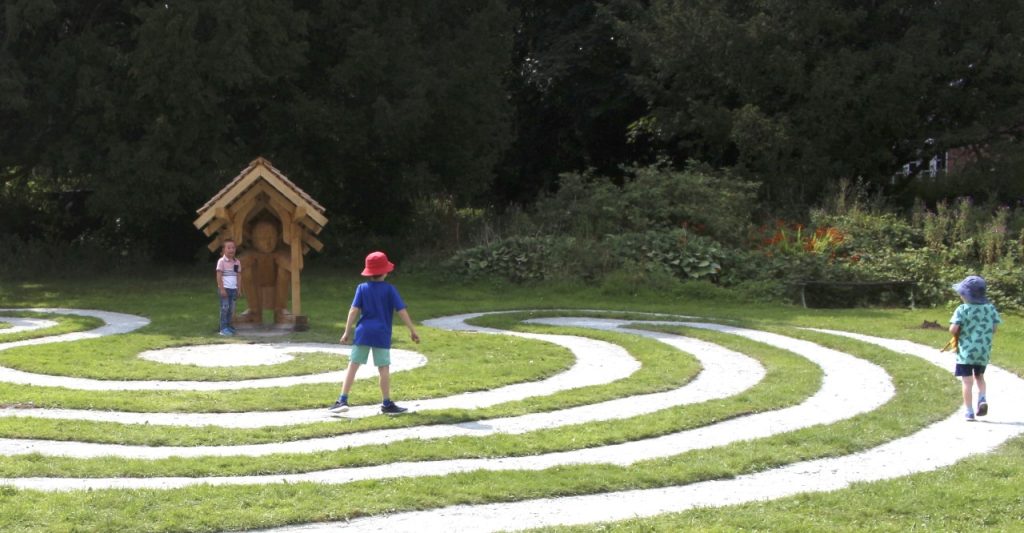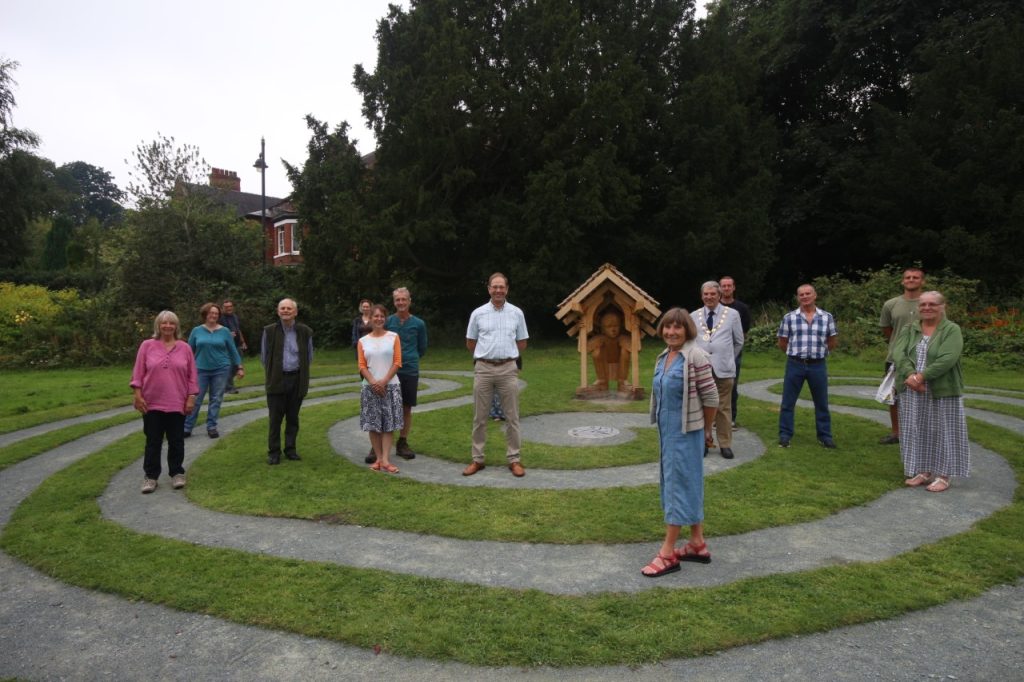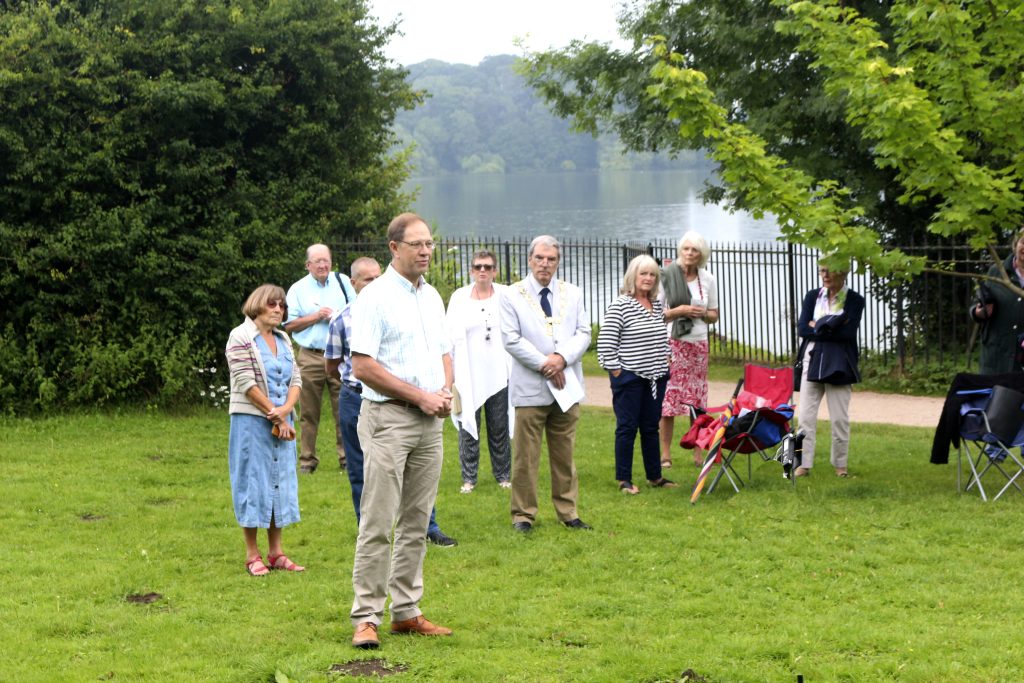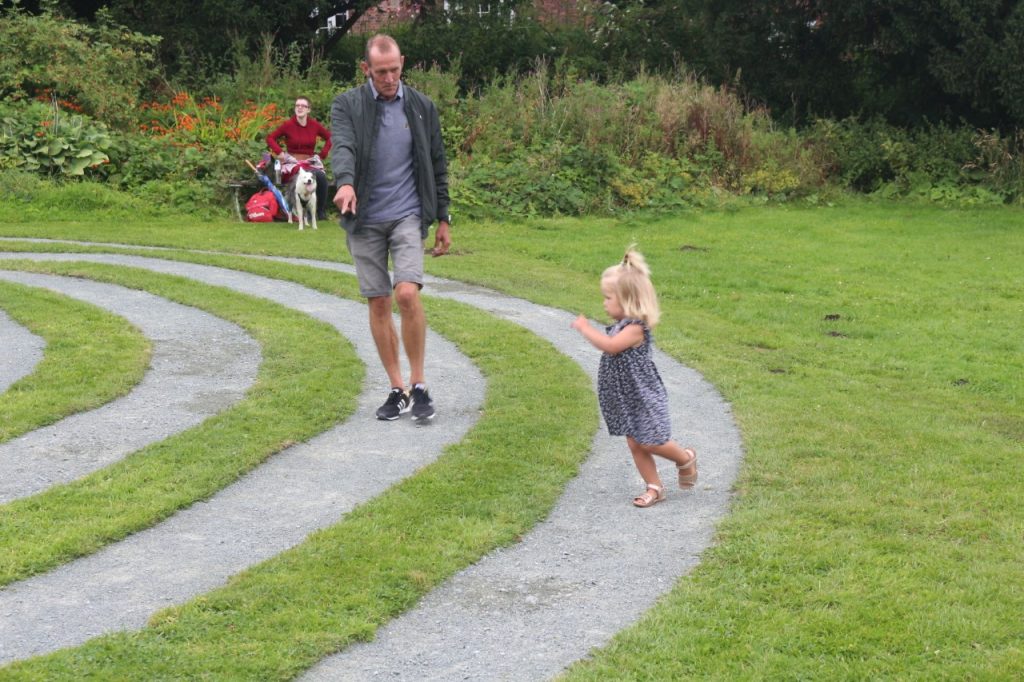News from our partners: Mere visitors can ‘walk in the footsteps of refugees’
News from our partners Ellesmere Sculpture Initiative
Visitors to a north Shropshire beauty spot are being encouraged to ‘walk in the footsteps of refugees’.
It follows the completion of a winding labyrinth footpath next to The Mere at Ellesmere, that has been created as part of a project to commemorate two local sisters who founded the Save the Children charity more than 100 years ago.
The labyrinth, at the entrance to Cremorne Gardens, symbolises the terrifying and often perilous journeys into the unknown, taken by vulnerable children fleeing war, famine and the effects of climate change. The United Nations has estimated that there are now nearly 30 million refugees in the world, half of them under the age of 18.

The new labyrinth is proving popular with children. Photo: David Atkinson.
The twisting, stone-covered track leads to a carved-oak sculpture depicting a refugee child trying to take shelter. It is part of a landmark art installation by the Ellesmere Sculpture Initiative to mark Save the Children’s centenary. A second 8ft high sculpture nearby, cast in high alumimina cement, is an abstract portrayal of Eglantyne Jebb and Dorothy Buxton, who launched the international aid charity in 1919.
The sisters, who were born less than a mile from The Mere, decided on direct action to provide food and medical aid to children left starving in Germany and other parts of central Europe at the end of World War I. The charity now operates in more than 100 countries.

Keeping their distance: guests, artists and volunteers mark the completion of the new labyrinth. Photo: David Atkinson.
Marker stones placed along the labyrinth have been inscribed with words in different languages – English, Kurdish and Rohingya – to convey the feelings of children displaced by conflict.
The idea for the labyrinth was inspired by children from seven local schools who took part in a series of briefing sessions and art workshops in which they were asked to imagine life as a refugee.
It has been developed with the help of Shrewsbury-based artists Sculpturelogic and laid out by ecological ground-workers Orchardfield. The area will be planted with shrubs and flowers to form the Jebb garden.

Richard Jebb, great-great nephew of Eglantyne and Dorothy, at an informal ceremony to mark the completion of the memorial art installation. Photo: David Atkinson.
Ellesmere’s mayor, Councillor Paul Goulbourne, praised the memorial art installation at an informal ceremony to mark its completion attended by the artists involved and members of the Jebb family, including Egantyne’s great nephew, Lionel Jebb and his son, Richard. He said it was a fitting tribute to the two sisters and hoped it would attract more visitors to The Mere.
The sculpture group’s artistic co-ordinator Trudi Graham said:
“The schoolpupils have been amazing, and we have been deeply touched and impressed at the way in which they immediately identified with the plight of refugee children and their fears of being lost with nowhere to go. We hope visitors to The Mere will empathise in a similar way as they walk the labyrinth, and hopefully pause for a moment to think of those for whom there is no safe haven.
“People respond to art works in many ways. One visitor who was photographing ‘The Sisters’ sculpture a few days ago, said she was sending the picture to her cousin whose sister was seriously ill. She said ‘sculpture can communicate in a way that nothing else can’.
“Eglantyne and Dorothy spent a happy childhood in Ellesmere, where they learnt the values that influenced their lives as great humanitarians. Our project aims to recognise and raise awareness of the impact that their pioneering work has had in so many countries where Save the Children operates. It also shows that Ellesmere is proud of these two remarkable, far-sighted women, and that they should not be forgotten.”
The art installation – the latest addition to the Ellesmere Sculpture Trail – has been funded by grants from the Heritage Lottery Fund and Arts Council England, donations from local businesses and community organisations, and support from Shropshire Council and Ellesmere Town Council.

On the right track: Two year old Lacey McEwan, from Shrewsbury, with her Grandad, Phil. Photo: David Atkinson.
Len Graham, the group’s chairman, said:
”We are delighted to see so many visitors enjoying and engaging with the sculptures and labyrinth, in this time of uncertainty and restrictions, because of coronavirus, people are making the most of our beautiful parklands and their facilities. Over the past 18 months, we have been involved in at least 49 events and activities to mark Save the Children’s centenary. We are extremely grateful to everyone in the local community, individuals, businesses and organisations who have supported us and helped to make the Jebb Garden possible.”
For more information, please contact John Shone, Publicity Officer, Ellesmere Sculpture Initiative – 01691 624514.

